Hydrology: Attributes of a Healthy Stream
An alluvial stream is one whose channel is composed of the sediments transported by the stream itself and that generally changes the shape of its bed as the rate of flow changes. (Adapted from Attributes of an alluvial river and their relation to water policy and management by Trash, McBain, and Leopold).
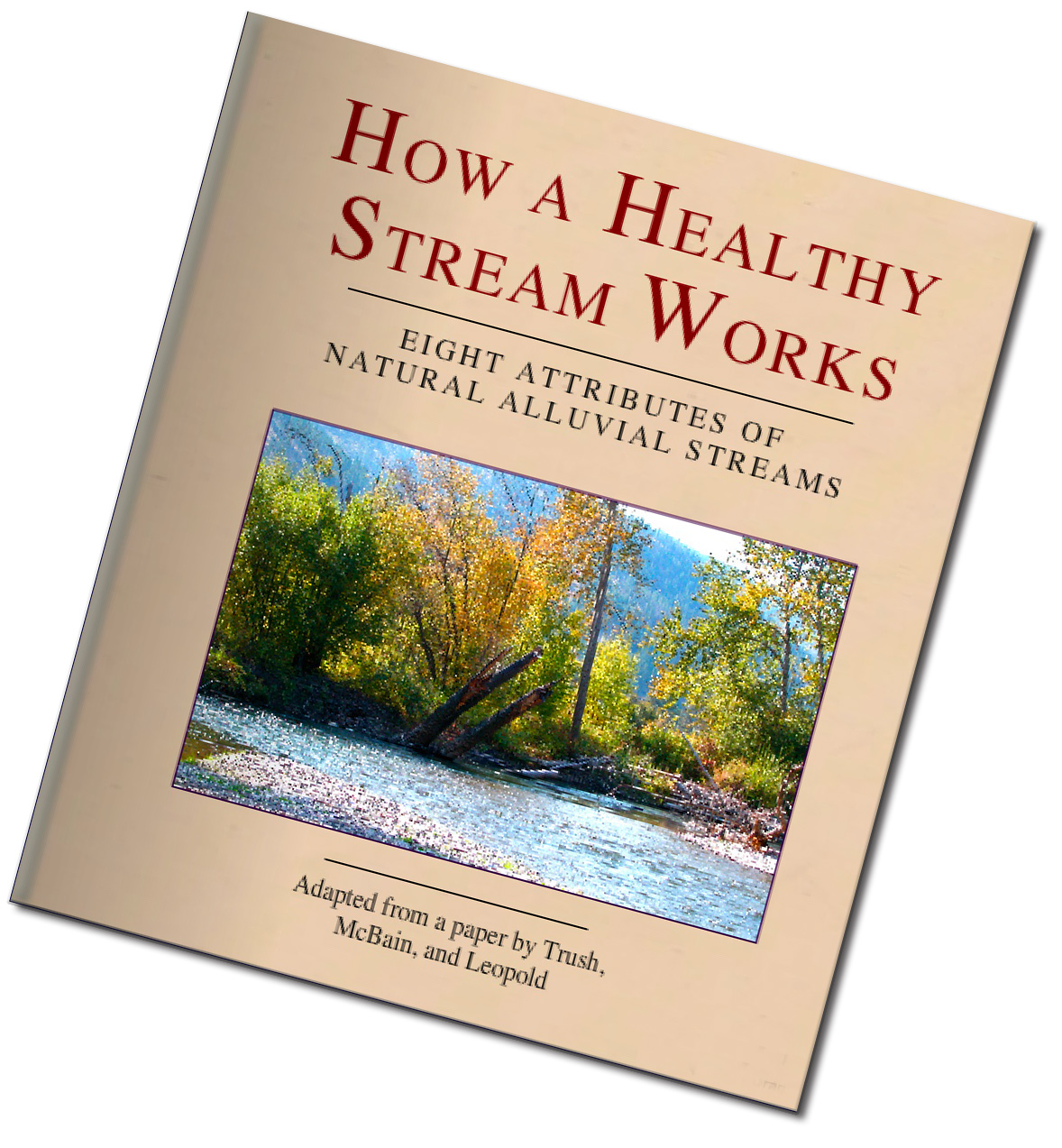
Attribute Six (Part A): : Floodplains Reduce Flood Flows
Naturally vegetated riparian areas serve a number of beneficial functions for flood control. An undeveloped, vegetated floodplain reduces the force, height, and volume of floodwaters by allowing them to spread out horizontally and relatively harmlessly across the floodplain. Water that floods into vegetated floodplains reenters the main channel slowly, enabling it to be soaked up by the "sponge" of the floodplain.
Riparian vegetation also intercepts and holds runoff from adjacent upland areas that would otherwise flow directly into rivers and exacerbate flooding conditions downstream. The root systems of streamside forest and emergent aquatic vegetation keep pores of the soil open so that two to three times more water can infiltrate the soil compared to lands used for cultivation or grazing.
In addition, trees, shrubs and herbaceous plants in riparian areas use large amounts of water in transpiration, which, in effect, transfers floodwaters to the atmosphere. Several thousand gallons per acre of water are used by plants each day, thereby drying the soil and making more room in the "soil sponge" for floodwater.
The combined effect of all of these functions is a significant reduction in peak flows and flooding downstream. Naturally vegetated riparian forests thus help prevent thousands of dollars in property damage and obviate the need for human-made flood control measures and structures.
Maintaining or reestablishing vegetation in riparian areas increases the water-holding capacity of soil, which helps to recharge groundwater supplies. The slowing and dispersal of runoff and floodwater by floodplain vegetation allows additional time for this water to infiltrate and recharge groundwater aquifers.
Floodplain soils and vegetation can also help to purify the water as it filters down to the aquifer. Once there, the clean groundwater can reemerge and seep back into surface water during the drier months and help reduce the frequency and duration of low streamflows and higher water temperatures.
The floodplain soaks up floodwater like a sponge. Later in the year when flows in the stream channel are low, that stored water slowly flows into the channel, providing cold, clear water when it is most needed by people, fish, and other organisms.
Spring High Water
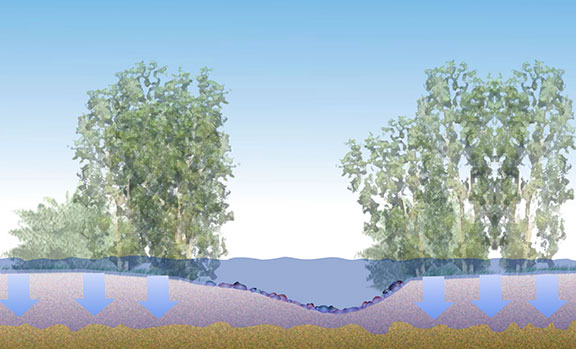
In spring, the floodplain soaks up flood waters.
Summer and Fall
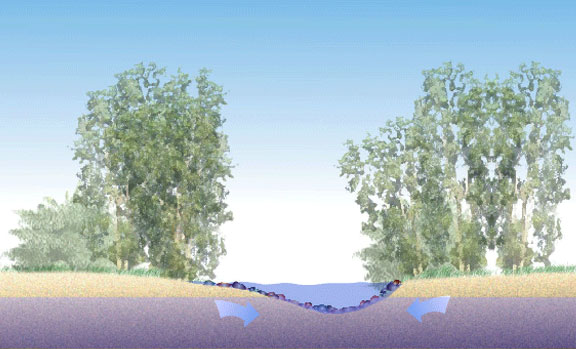
In the summer and fall, the floodplain slowly releases stored floodwaters back to the stream.
Hydrology: Attributes of a Healthy Stream
An alluvial stream is one whose channel is composed of the sediments transported by the stream itself and that generally changes the shape of its bed as the rate of flow changes. (Adapted from Attributes of an alluvial river and their relation to water policy and management by Trash, McBain, and Leopold).
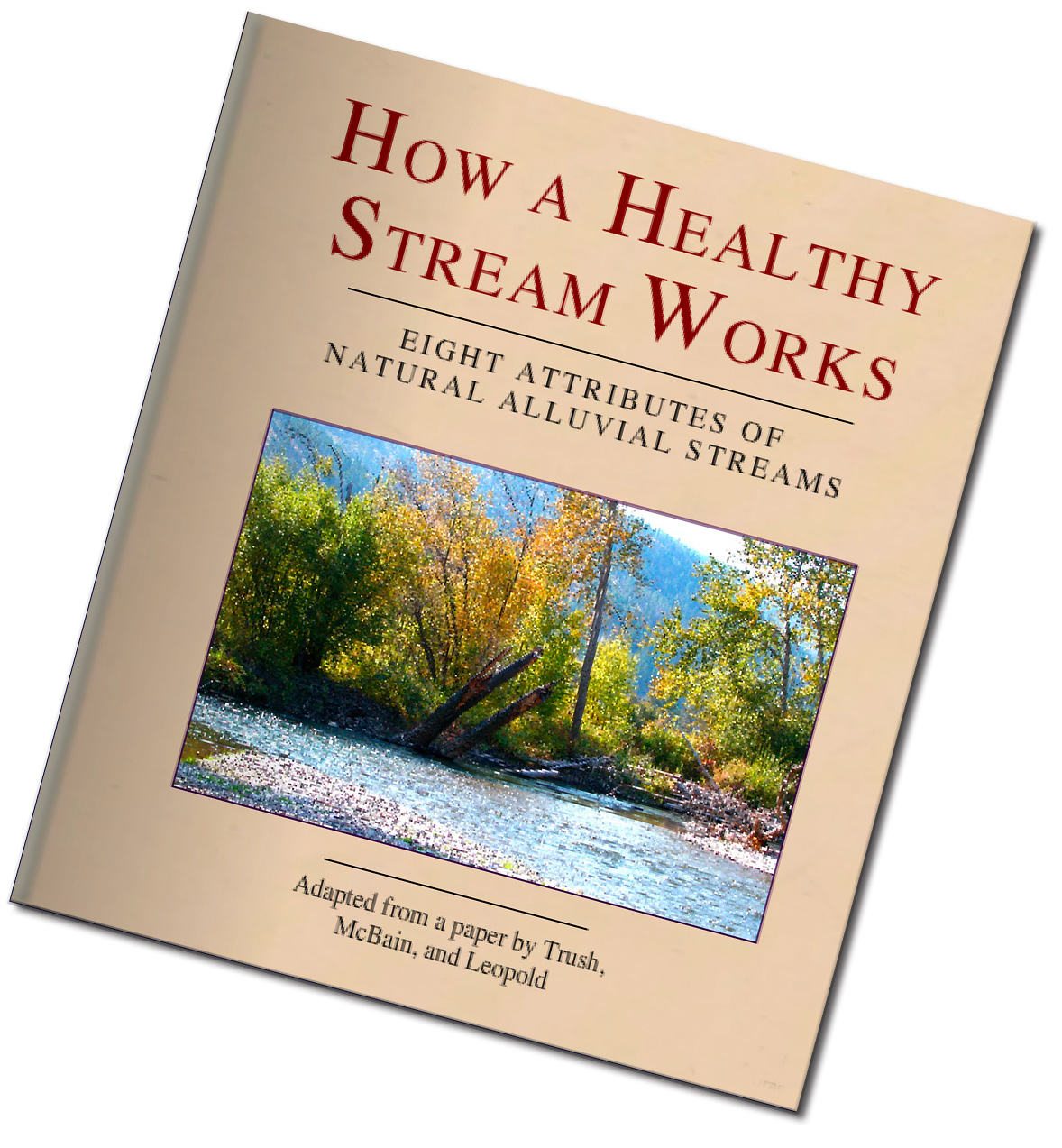
Attribute Six (Part A): : Floodplains Reduce Flood Flows
Naturally vegetated riparian areas serve a number of beneficial functions for flood control. An undeveloped, vegetated floodplain reduces the force, height, and volume of floodwaters by allowing them to spread out horizontally and relatively harmlessly across the floodplain. Water that floods into vegetated floodplains reenters the main channel slowly, enabling it to be soaked up by the "sponge" of the floodplain.
Riparian vegetation also intercepts and holds runoff from adjacent upland areas that would otherwise flow directly into rivers and exacerbate flooding conditions downstream. The root systems of streamside forest and emergent aquatic vegetation keep pores of the soil open so that two to three times more water can infiltrate the soil compared to lands used for cultivation or grazing.
In addition, trees, shrubs and herbaceous plants in riparian areas use large amounts of water in transpiration, which, in effect, transfers floodwaters to the atmosphere. Several thousand gallons per acre of water are used by plants each day, thereby drying the soil and making more room in the "soil sponge" for floodwater.
The combined effect of all of these functions is a significant reduction in peak flows and flooding downstream. Naturally vegetated riparian forests thus help prevent thousands of dollars in property damage and obviate the need for human-made flood control measures and structures.
Maintaining or reestablishing vegetation in riparian areas increases the water-holding capacity of soil, which helps to recharge groundwater supplies. The slowing and dispersal of runoff and floodwater by floodplain vegetation allows additional time for this water to infiltrate and recharge groundwater aquifers.
Floodplain soils and vegetation can also help to purify the water as it filters down to the aquifer. Once there, the clean groundwater can reemerge and seep back into surface water during the drier months and help reduce the frequency and duration of low streamflows and higher water temperatures.
The floodplain soaks up floodwater like a sponge. Later in the year when flows in the stream channel are low, that stored water slowly flows into the channel, providing cold, clear water when it is most needed by people, fish, and other organisms.
Spring High Water
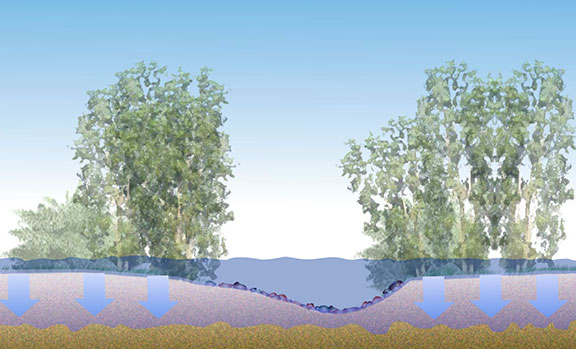
In spring, the floodplain soaks up flood waters.
Summer and Fall
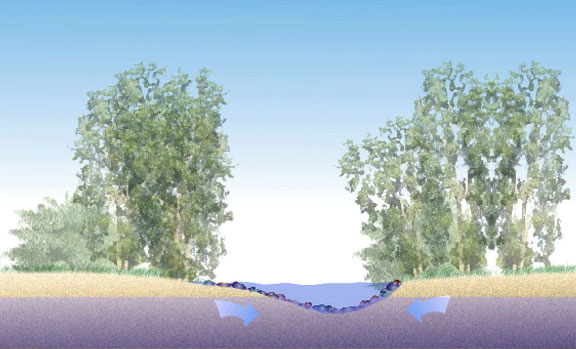
In the summer and fall, the floodplain slowly releases stored floodwaters back to the stream.
Hydrology: Attributes of a Healthy Stream
An alluvial stream is one whose channel is composed of the sediments transported by the stream itself and that generally changes the shape of its bed as the rate of flow changes. (Adapted from Attributes of an alluvial river and their relation to water policy and management by Trash, McBain, and Leopold).
Attribute Six (Part A): : Floodplains Reduce Flood Flows
Naturally vegetated riparian areas serve a number of beneficial functions for flood control. An undeveloped, vegetated floodplain reduces the force, height, and volume of floodwaters by allowing them to spread out horizontally and relatively harmlessly across the floodplain. Water that floods into vegetated floodplains reenters the main channel slowly, enabling it to be soaked up by the "sponge" of the floodplain.
Riparian vegetation also intercepts and holds runoff from adjacent upland areas that would otherwise flow directly into rivers and exacerbate flooding conditions downstream. The root systems of streamside forest and emergent aquatic vegetation keep pores of the soil open so that two to three times more water can infiltrate the soil compared to lands used for cultivation or grazing.
In addition, trees, shrubs and herbaceous plants in riparian areas use large amounts of water in transpiration, which, in effect, transfers floodwaters to the atmosphere. Several thousand gallons per acre of water are used by plants each day, thereby drying the soil and making more room in the "soil sponge" for floodwater.
The combined effect of all of these functions is a significant reduction in peak flows and flooding downstream. Naturally vegetated riparian forests thus help prevent thousands of dollars in property damage and obviate the need for human-made flood control measures and structures.
Maintaining or reestablishing vegetation in riparian areas increases the water-holding capacity of soil, which helps to recharge groundwater supplies. The slowing and dispersal of runoff and floodwater by floodplain vegetation allows additional time for this water to infiltrate and recharge groundwater aquifers.
Floodplain soils and vegetation can also help to purify the water as it filters down to the aquifer. Once there, the clean groundwater can reemerge and seep back into surface water during the drier months and help reduce the frequency and duration of low streamflows and higher water temperatures.
The floodplain soaks up floodwater like a sponge. Later in the year when flows in the stream channel are low, that stored water slowly flows into the channel, providing cold, clear water when it is most needed by people, fish, and other organisms.
Spring High Water
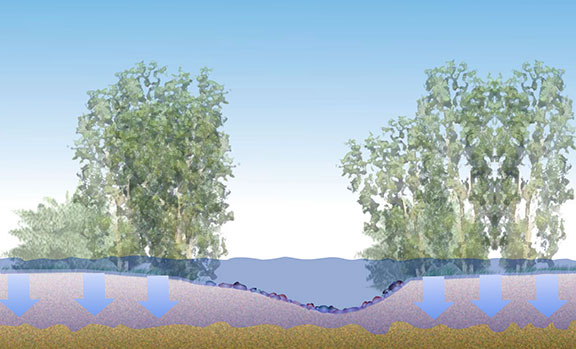
In spring, the floodplain soaks up flood waters.
Summer and Fall
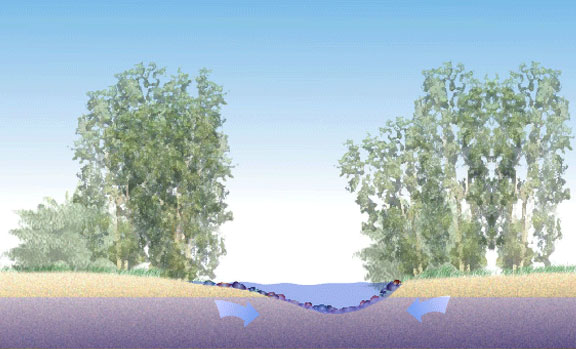
In the summer and fall, the floodplain slowly releases stored floodwaters back to the stream.